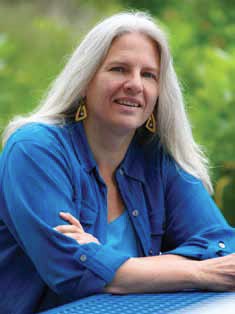By Katherine M. Parisky (Originally published in Brandeis Catalyst)
Liz Hedstrom’s research targets a waterborne pathogen and potential biowarfare agent.
Discovered in 1976, cryptosporidium lurks worldwide in water, contaminating swimming pools, water parks, and drinking water supplies. Although it has even been featured on the comedy show The Colbert Report, it is no laughing matter— this microscopic pathogen is a leading cause of diarrhea and malnutrition and the most common infection in immunocompromised people such as AIDS patients. Cryptosporidium invades the small intestine, where it opens fire, typically causing severe gastrointestinal distress and even death in people with weakened immune systems.
In 1993, in the largest waterborne disease outbreak in U.S. history, this nasty protozoan parasite infiltrated Milwaukee’s municipal water supply, killing more than 100 people and sickening another 403,000. Cryptosporidium is a hardy foe whose oocysts—products of a spore-like phase— remain stable outside a host for long periods and are resistant to conventional water treatment such as chlorine disinfection.
 |
| Liz Hedstrom |
For the last half decade, Hedstrom has been working in collaboration with Boris Striepen, a parasitologist at the University of Georgia, to develop drugs to treat cryptosporidiosis. Currently approved drugs are ineffective, and there is no vaccine. Her research has generated two patent filings so far, with additional patents soon to follow, all with an eye to bringing to market new drugs to conquer cryptosporidium.
Hedstrom and her collaborators made a critical breakthrough in eroding cryptosporidium defenses when they identified IMPDH, a key enzyme involved in the biosynthesis of RNA and DNA, as a potential drug target. Her research has shown that IMPDH inhibitors block the parasite from proliferating in vitro. Importantly, the cryptosporidium IMPDH has very different properties from those of the human enzyme counterpart. The next step was to identify compounds that blocked the action of the cryptosporidium IMPDH, but spared human IMPDH.
Leading a large-scale screen of a commercial library containing 129,000 compounds at the New England Regional Center of Excellence for Biodefense and Emerging Infectious Diseases, in Cambridge, Massachusetts, Hedstrom discovered more than fifty compounds that specifically inhibit the parasite enzyme. Several of these compounds display antiparasitic activity.
“We have some nice compounds, which we are now trying to improve to make them more potent, more bioavailable, and more metabolically stable. We’re a long way from an actual drug at this point, but I like our chances,” says Hedstrom.
“Liz Hedstrom has gone beyond the basic biochemistry and has screened compounds that affect cryptosporidium, and we have patent claims on these compounds,” says Irene Abrams, executive director of Brandeis’s Office of Technology Licensing. “I am very optimistic that the compounds may become a lead candidate for a drug, and we are currently seeking commercial partners to take these compounds in-house and continue their development.”
“We are looking forward to working with companies in developing novel drugs to treat cryptosporidiosis and prevent transmission. The team’s goal now,” Hedstrom explains, “is to achieve proof of concept in an animal model of cryptosporidium infection.”
Katherine M. Parisky is a postdoctoral student in biology.
No comments:
Post a Comment